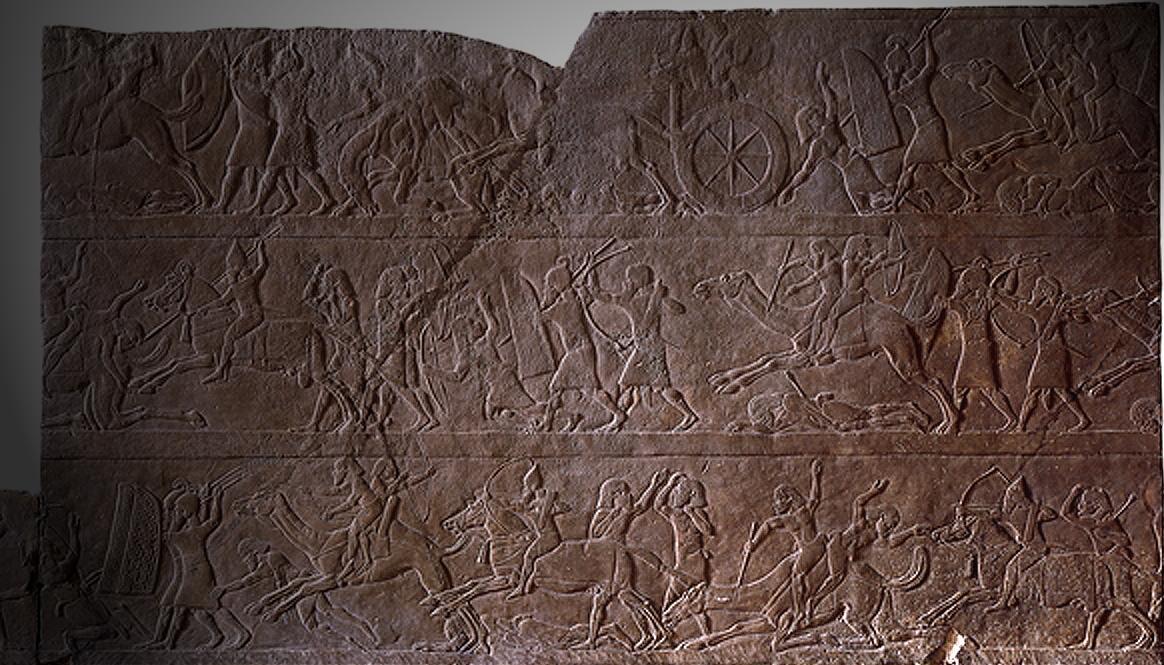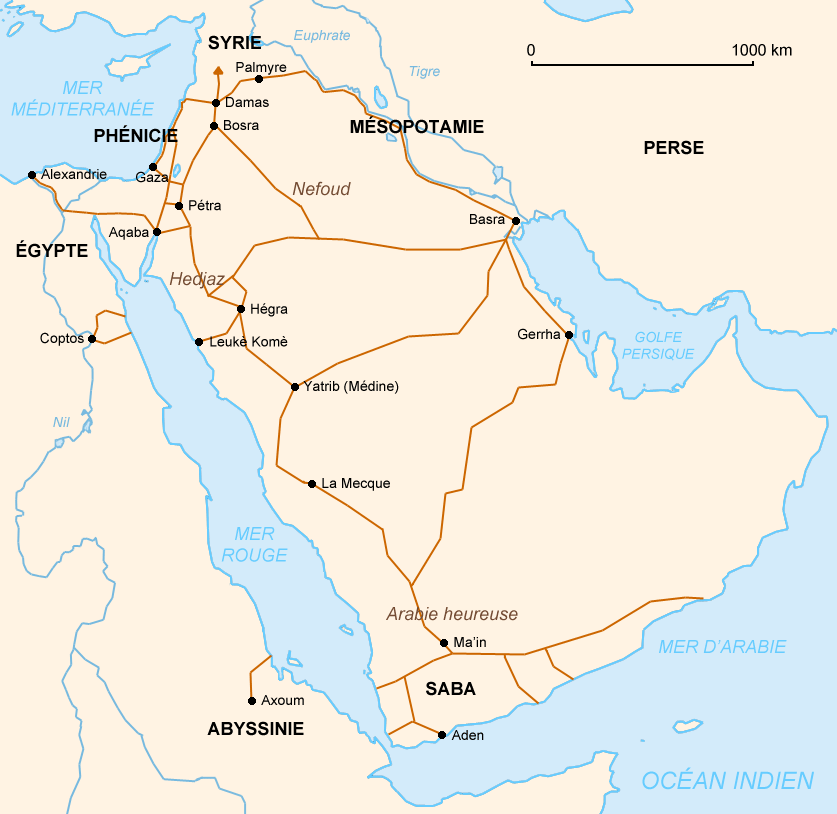|
Children Of Ishmael
The Ishmaelites ( he, ''Yīšməʿēʾlīm,'' ar, بَنِي إِسْمَاعِيل ''Bani Isma'il''; "sons of Ishmael") were a collection of various Arabian tribes, confederations and small Realm, kingdoms described in Islamic tradition as being descended from and named after Ishmael, a prophet according to the Quran, the first son of Abraham and the Egyptian Hagar. According to the Book of Genesis in the Hebrew Bible, Ishmael had one daughter and twelve sons, the "twelve princes" mentioned in Genesis 17:20. In Islamic tradition, this gave rise to the "Twelve Tribes of Ishmael", Arab tribes from which the early Muslims were descended. In Jewish tradition, the Twelve Tribes of Israel were descended from Abraham's other son, Isaac, via Isaac's son Jacob. These traditions are accepted by both Islam and Judaism. Book of Genesis, Genesis and 1 Chronicles describe the Qedarites as a tribe descended from the second son of Ishmael, Qedar. Some Abrahamic scholars described the histori ... [...More Info...] [...Related Items...] OR: [Wikipedia] [Google] [Baidu] |
Mecca
Mecca (; officially Makkah al-Mukarramah, commonly shortened to Makkah ()) is a city and administrative center of the Mecca Province of Saudi Arabia, and the Holiest sites in Islam, holiest city in Islam. It is inland from Jeddah on the Red Sea, in a narrow valley above sea level. Its last recorded population was 1,578,722 in 2015. Its estimated metro population in 2020 is 2.042million, making it the List of cities in Saudi Arabia by population, third-most populated city in Saudi Arabia after Riyadh and Jeddah. Pilgrims more than triple this number every year during the Pilgrimage#Islam, pilgrimage, observed in the twelfth Islamic calendar, Hijri month of . Mecca is generally considered "the fountainhead and cradle of Islam". Mecca is revered in Islam as the birthplace of the Prophets and messengers in Islam, Islamic prophet Muhammad. The Hira cave atop the ("Mountain of Light"), just outside the city, is where Muslims believe the Quran was first revealed to Muhammad. Vis ... [...More Info...] [...Related Items...] OR: [Wikipedia] [Google] [Baidu] |
Qedarites
The Qedarites ( ar, قيدار, Qaydār) were a largely nomadic ancient Arab people, Arab tribal confederation centred in the Wadi Sirhan, Wādī Sirḥān in the Syrian Desert. Attested from the 8th century BC, the Qedarites formed a powerful polity which expanded its territory over the course of the 8th to 5th centuries BC to cover a large area in northern Arabia stretching from the western borders of Babylonia to the eastern borders of Egypt.Stearns and Langer, 2001, p. 41. The Qedarites played an important role in the history of the Levant and of North Arabian Peninsula, Arabia, where they enjoyed close relations with the nearby Canaan#Canaanites, Canaanite and Aramaeans, Aramaean states, and became important participants in the trade of spices and aromatics imported into the Fertile Crescent and the Mediterranean world from South Arabia. Having engaged in both friendly ties and hostilities with the Mesopotamian powers such as the Neo-Assyrian Empire, Neo-Assyrian and Neo-Bab ... [...More Info...] [...Related Items...] OR: [Wikipedia] [Google] [Baidu] |
Qedar
The Qedarites ( ar, قيدار, Qaydār) were a largely nomadic ancient Arab tribal confederation centred in the Wādī Sirḥān in the Syrian Desert. Attested from the 8th century BC, the Qedarites formed a powerful polity which expanded its territory over the course of the 8th to 5th centuries BC to cover a large area in northern Arabia stretching from the western borders of Babylonia to the eastern borders of Egypt.Stearns and Langer, 2001, p. 41. The Qedarites played an important role in the history of the Levant and of North Arabia, where they enjoyed close relations with the nearby Canaanite and Aramaean states, and became important participants in the trade of spices and aromatics imported into the Fertile Crescent and the Mediterranean world from South Arabia. Having engaged in both friendly ties and hostilities with the Mesopotamian powers such as the Neo-Assyrian and Neo-Babylonian empires, the Qedarites eventually became integrated within the structure of the Pers ... [...More Info...] [...Related Items...] OR: [Wikipedia] [Google] [Baidu] |
King James Version
The King James Version (KJV), also the King James Bible (KJB) and the Authorized Version, is an Bible translations into English, English translation of the Christian Bible for the Church of England, which was commissioned in 1604 and published in 1611, by sponsorship of King James VI and I. The List of books of the King James Version, 80 books of the King James Version include 39 books of the Old Testament, an Intertestamental period, intertestamental section containing 14 books of what Protestantism, Protestants consider the Biblical apocrypha#King James Version, Apocrypha, and the 27 books of the New Testament. Noted for its "majesty of style", the King James Version has been described as one of the most important books in English culture and a driving force in the shaping of the English-speaking world. The KJV was first printed by John Norton and Robert Barker (printer), Robert Barker, who both held the post of the King's Printer, and was the third translation into Englis ... [...More Info...] [...Related Items...] OR: [Wikipedia] [Google] [Baidu] |
Heir
Inheritance is the practice of receiving private property, titles, debts, entitlements, privileges, rights, and obligations upon the death of an individual. The rules of inheritance differ among societies and have changed over time. Officially bequeathing private property and/or debts can be performed by a testator via will, as attested by a notary or by other lawful means. Terminology In law, an ''heir'' is a person who is entitled to receive a share of the deceased's (the person who died) property, subject to the rules of inheritance in the jurisdiction of which the deceased was a citizen or where the deceased (decedent) died or owned property at the time of death. The inheritance may be either under the terms of a will or by intestate laws if the deceased had no will. However, the will must comply with the laws of the jurisdiction at the time it was created or it will be declared invalid (for example, some states do not recognise handwritten wills as valid, or only in s ... [...More Info...] [...Related Items...] OR: [Wikipedia] [Google] [Baidu] |
Sarah
Sarah (born Sarai) is a biblical matriarch and prophetess, a major figure in Abrahamic religions. While different Abrahamic faiths portray her differently, Judaism, Christianity, and Islam all depict her character similarly, as that of a pious woman, renowned for her hospitality and beauty, the wife and half-sister of Abraham, and the mother of Isaac. Sarah has her feast day on 1 September in the Catholic Church, 19 August in the Coptic Orthodox Church, 20 January in the LCMS, and 12 and 20 December in the Eastern Orthodox Church. In the Hebrew Bible Family According to Book of Genesis 20:12, in conversation with the Philistine king Abimelech of Gerar, Abraham reveals Sarah to be both his wife and his half-sister, stating that the two share a father but not a mother. Such unions were later explicitly banned in the Book of Leviticus (). This would make Sarah the daughter of Terah and the half-sister of not only Abraham but Haran and Nahor. She would also have been the au ... [...More Info...] [...Related Items...] OR: [Wikipedia] [Google] [Baidu] |
Qedarites Map
The Qedarites ( ar, قيدار, Qaydār) were a largely nomadic ancient Arab tribal confederation centred in the Wādī Sirḥān in the Syrian Desert. Attested from the 8th century BC, the Qedarites formed a powerful polity which expanded its territory over the course of the 8th to 5th centuries BC to cover a large area in northern Arabia stretching from the western borders of Babylonia to the eastern borders of Egypt.Stearns and Langer, 2001, p. 41. The Qedarites played an important role in the history of the Levant and of North Arabia, where they enjoyed close relations with the nearby Canaanite and Aramaean states, and became important participants in the trade of spices and aromatics imported into the Fertile Crescent and the Mediterranean world from South Arabia. Having engaged in both friendly ties and hostilities with the Mesopotamian powers such as the Neo-Assyrian and Neo-Babylonian empires, the Qedarites eventually became integrated within the structure of the Persia ... [...More Info...] [...Related Items...] OR: [Wikipedia] [Google] [Baidu] |
Assyrian Empire
Assyrian may refer to: * Assyrian people, the indigenous ethnic group of Mesopotamia. * Assyria, a major Mesopotamian kingdom and empire. ** Early Assyrian Period ** Old Assyrian Period ** Middle Assyrian Empire ** Neo-Assyrian Empire * Assyrian language (other) * Assyrian Church (other) * SS ''Assyrian'', several cargo ships * ''The Assyrian'' (novel), a novel by Nicholas Guild * The Assyrian (horse), winner of the 1883 Melbourne Cup See also * Assyria (other) * Syriac (other) * Assyrian homeland, a geographic and cultural region in Northern Mesopotamia traditionally inhabited by Assyrian people * Syriac language, a dialect of Middle Aramaic that is the minority language of Syrian Christians * Upper Mesopotamia Upper Mesopotamia is the name used for the Upland and lowland, uplands and great outwash plain of northwestern Iraq, northeastern Syria and southeastern Turkey, in the northern Middle East. Since the early Muslim conquests of the m ... [...More Info...] [...Related Items...] OR: [Wikipedia] [Google] [Baidu] |
Incense
Incense is aromatic biotic material that releases fragrant smoke when burnt. The term is used for either the material or the aroma. Incense is used for aesthetic reasons, religious worship, aromatherapy, meditation, and ceremony. It may also be used as a simple deodorant or insect repellent. Incense is composed of aromatic plant materials, often combined with essential oils. The forms taken by incense differ with the underlying culture, and have changed with advances in technology and increasing number of uses. Incense can generally be separated into two main types: "indirect-burning" and "direct-burning". Indirect-burning incense (or "non-combustible incense") is not capable of burning on its own, and requires a separate heat source. Direct-burning incense (or "combustible incense") is lit directly by a flame and then fanned or blown out, leaving a glowing ember that smoulders and releases a smoky fragrance. Direct-burning incense is either a paste formed around a bamboo stic ... [...More Info...] [...Related Items...] OR: [Wikipedia] [Google] [Baidu] |
Babylonia
Babylonia (; Akkadian: , ''māt Akkadī'') was an ancient Akkadian-speaking state and cultural area based in the city of Babylon in central-southern Mesopotamia (present-day Iraq and parts of Syria). It emerged as an Amorite-ruled state c. 1894 BCE. During the reign of Hammurabi and afterwards, Babylonia was called "the country of Akkad" (''Māt Akkadī'' in Akkadian), a deliberate archaism in reference to the previous glory of the Akkadian Empire. It was often involved in rivalry with the older state of Assyria to the north and Elam to the east in Ancient Iran. Babylonia briefly became the major power in the region after Hammurabi ( fl. c. 1792–1752 BCE middle chronology, or c. 1696–1654 BCE, short chronology) created a short-lived empire, succeeding the earlier Akkadian Empire, Third Dynasty of Ur, and Old Assyrian Empire. The Babylonian Empire rapidly fell apart after the death of Hammurabi and reverted to a small kingdom. Like Assyria, the Babylonian state retained ... [...More Info...] [...Related Items...] OR: [Wikipedia] [Google] [Baidu] |








